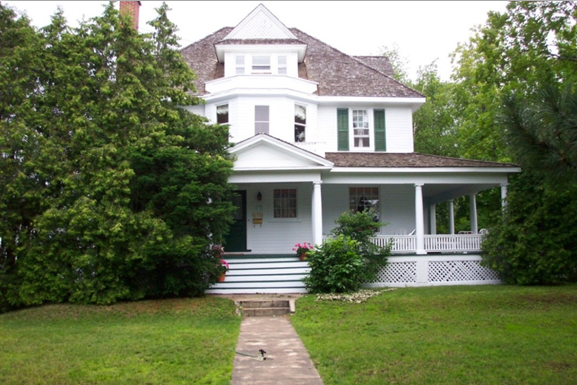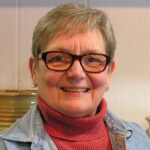With its wooden clapboard siding and wraparound porch, the house that our family moved into on Copeland Street in 1945 was an iconic small-town residence – the kind moviemakers seek out to convey a nostalgic ambiance. Think “The Waltons”. Ubiquitous domestic architecture found everywhere, built in the late 19th or early 20th century.
The house required some TLC to bring it up to the standards of the day, mainly painting and upgrades to the electrical and plumbing systems, which dad undertook himself. The biggest challenge was the heating system, a wood-burning behemoth in the middle of the basement. As soon as we moved in, dad ordered a new oil-burning furnace. Unfortunately, as was the case for a lot of items after WW2, there was a backlog of orders, so we had to live with the old wood-burner for over two years!
See Ian Saunder’s first column about his family’s time on Copeland Street in the Winter 2022 edition. For a copy, email: [email protected]
That old furnace didn’t burn regular firewood, but needed ‘slabs’- the semicircular pieces of wood sliced off logs to change their shape from round to square. Each piece was about six feet long, and the slabs had to be thrown in and stacked through the furnace’s big door. It was essentially free fuel for Mr. Milne who was in the lumber business. It was fun for me to watch dad throw in the slabs – the blazing fire reminded me of the illustration in my “Hurlbut’s Stories of the Bible” wherein old King Nebuchadnezzar had thrown some poor unfortunates into the flames. I’m sure it wasn’t fun for dad. The furnace had to be fed constantly, even once during the night in midwinter, just to keep pipes from freezing. In addition, because those big slabs of wood were somewhat green, it caused us to experience periodic chimney fires. Flames would shoot out of the top of the chimney and push sparks into the living room.


Of course, at four or five years of age, I never thought of the potential danger to the house; I just enjoyed seeing the big red fire trucks roaring up to the house with sirens wailing and lights flashing. With these upgrades in place, we settled into everyday life, enjoying family life and routines. The house was on a pleasant homesite, set back as it was on a large corner lot, bounded on both street sides by a white picket fence. Just inside the fence was a row of large trees spaced at twenty foot intervals. Maples along the front, Elms on Murray Street. Those maples remain to this day, but Dutch Elm Disease claimed the others.
As years went by, I was expected to do some chores, and at some point it fell on me to do the weekly lawn mowing -that large lot I alluded to above was covered with grass!. The lawn was divided into three patches, one to the side of the house, and two in the front (those were demarked by the walk from Copeland Street to the front veranda. I was grateful for the separate grass areas, since I could mow one area per day. On the fourth day, I’d tackle the boulevards, which took the longest, because of utility poles and trimming the grass along the fences. In the height of summer, lawn-cutting was almost a continuous process.
The Senator’s widow lived there until her death, and I can still picture her being chauffeured in her black 1946 Cadillac sedan.
Dad declined my requests for a gas mower, alleging that they didn’t do as good a job as a push mower. While there was truth to his claim, I’m inclined to believe that a power mower might have been purchased if he’d been the one pushing the old clunker!
The neighborhood we lived in was a mixed one, in terms of house size and architectural style. Perhaps because of the large trees which were common to most properties in the area, all seemed to fit together. Diagonally across from us, for example, on the southeast corner of Murray and Copeland Streets. was a large four-story brick cube of a house, built before WWI. (Its architect was Harry Angus, the same one who designed our house) Easily North Bay’s largest private residence at the time, it was the home of the late Senator George Gordon, who served in that capacity from 1912 to 1942. Surrounded by a wrought-iron fence, it looked as if it might have been a city gentlemen’s club. The Senator’s widow lived there until her death, and I can still picture her being chauffeured in her black 1946 Cadillac sedan.
Most of the neighborhood’s houses were brick, with a wood porch across the front, and most would have been built from 1914 to about 1930, although three doors down was a small, pink brick bungalow where the Teskey’s lived, built about 1948. Our house, being on the corner, afforded a good view of the neighboring streets and activities. The old high school, North Bay Collegiate Institute and Vocational School was visible from our back door.
Those who were born in the years from 1946 to 1964 are called “baby boomers” for good reason.
It was in the middle of the oldest residential section of North Bay, before one crossed the CNR tracks on Jane Street, and started up “The Hill” – the appellation informally given to the area immediately north and east of us. There was nothing particularly large or impressive about any of the homes in the area, but it was quite a pleasant district, and was considered ‘the place’ to build a new home. True to its name, the land did rise at that point, and it was here that much of postwar new housing was built.
One thing that has always struck me about a lot of the housing that was built in the decade after World War II was just how small the houses were relative to those that typically would be built later. Those who were born in the years from 1946 to 1964 are called “baby boomers” for good reason. As those in military service returned home and started families the demand for adequate housing was monumental, so building a large number of smaller “starter homes” made total sense for the times.


Back then, the typical new home seemed to be a three bedroom house, with a second floor bathroom, and if it were really glitzy, a downstairs powder room. There’d be a living room, dining room and kitchen on the first floor, and that’s about all. Laundry facilities would be in the basement near the furnace. The basement space is also where future additional living space was added- ground floor family rooms were unheard of. These rooms were called by different names – most often “rec room” or “playroom”. One of my friend’s parents called the one in their house a “rumpus room”. In any case it added needed additional area to these post war dwellings.
I remember dad’s assistant at the ONR’s Engineering Department, Jack Cooper had a house built for his family of four in “The Hill”, up on Browning Street. It was a three-bay front brick Dutch colonial. It was an attractive house, but when I saw it again on a visit to North Bay years later, I couldn’t believe how small it actually was.
As I said earlier, the area where we lived was older, unnamed and its borders never defined. But located as it was at Copeland and Murray Streets, it was definitely near the neighborhood’s core. That intersection was, for all the time I lived there, unprotected by a stop sign on any of the corners. As a result, three or four times per year, we’d hear a screech of brakes, followed by a crash, as two vehicles tried to cross the intersection at the same time. Fortunately, to my recollection, no one was ever injured, but lots of cars were banged up. Why it took decades for the powers that be at city hall to decide to send a crew out and install a pair of stop signs baffles me. Maybe they considered the minor collisions neighborhood entertainment!
I’d love to hear feedback (and your stories) from readers, so contact me at: [email protected]


Ian Saunders was born in North Bay in 1942 and lived there for 20 years before a life elsewhere. He has been writing a family memoir and is sharing some of the North Bay connections in Back in the Bay Magazine. Email: [email protected]







